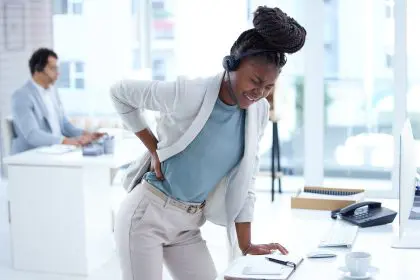Back pain is a common issue that affects people of all ages, impacting daily routines and overall well-being. Whether it’s a sharp, shooting pain or a dull ache that lingers for days, understanding the root causes of back pain can help prevent it from becoming a chronic problem. Many everyday activities may contribute to this discomfort without you even realizing it. Below, we explore five common activities that cause back pain and how to minimize the risk of injury.
1. Sitting for extended periods
Sitting for prolonged hours, especially in poor posture, is one of the most frequent causes of back pain. Whether you’re at a desk, behind the wheel, or lounging on the couch, sitting for too long places significant stress on your spine. This strain often leads to muscle fatigue, stiff joints, and spinal disc pressure, all of which can result in back pain.
The slouched position most people fall into after sitting for extended periods reduces the natural curve of the spine, leading to poor spinal alignment. Over time, this poor posture weakens the muscles that support the spine, making you more prone to injury.
Solution: Regularly changing your posture and incorporating movement into your routine are key ways to avoid pain caused by long periods of sitting. Standing up, stretching, and walking around every 30 minutes can help relieve tension in your back muscles. Investing in ergonomic chairs that provide proper lumbar support can also significantly reduce the strain on your back.
2. Lifting heavy objects improperly
Many people don’t realize how much strain lifting heavy objects can place on the back, especially when done incorrectly. Improper lifting techniques—such as bending at the waist rather than at the knees—place a lot of pressure on the lower back, increasing the risk of muscle strains and disc injuries. In some cases, this can even lead to herniated discs, a condition that causes severe, persistent back pain.
Whether you’re picking up a heavy box, groceries, or gym weights, failing to engage your core and distribute the load evenly can wreak havoc on your back. Even lifting moderately heavy objects incorrectly on a regular basis can cause cumulative damage over time.
Solution: Always lift by bending at the knees, not the waist. Keep the object close to your body, and engage your core to distribute the load. If something is too heavy, don’t hesitate to ask for help or use equipment such as a dolly to avoid straining your back.
3. Sleeping on a poor-quality mattress
You spend a significant portion of your life in bed, so it’s no surprise that the quality of your mattress can have a profound impact on your back health. A mattress that doesn’t support your body properly—whether it’s too soft, too firm, or old and sagging—can lead to back pain. Poor spinal alignment during sleep causes the muscles and ligaments in your back to work overtime to keep your spine in its natural position, often resulting in morning back pain.
Additionally, certain sleeping positions can put extra pressure on your back, contributing to discomfort. Sleeping on your stomach, for instance, can hyperextend the spine, exacerbating back issues.
Solution: Investing in a high-quality, supportive mattress is essential for preventing back pain. Opt for a medium-firm mattress that keeps your spine aligned while providing enough cushioning for comfort. Additionally, sleeping on your side with a pillow between your knees can help maintain a neutral spine position, alleviating pressure on your back.
4. Engaging in high-impact sports or activities
While staying active is critical for overall health, certain high-impact sports and activities can increase the risk of back pain. Activities like running, basketball, gymnastics, and weightlifting involve repetitive motions, sudden movements, or heavy loads, which can stress the muscles, ligaments, and discs in your back.
Running on hard surfaces, for example, puts a lot of pressure on your spine and lower back due to the constant impact with each step. Without proper form or the right equipment, these activities can lead to both acute injuries and long-term back issues.
Solution: If you’re involved in high-impact sports, it’s crucial to focus on proper technique and form to minimize stress on your back. Warming up, stretching, and cooling down are important steps to avoid injury. Additionally, strengthening your core muscles can provide better support for your back, reducing the risk of injury during high-impact activities.
5. Poor posture during daily tasks
Many people unknowingly maintain poor posture while engaging in daily tasks, contributing to back pain over time. Activities like standing for extended periods, working on a computer, using a smartphone, and even brushing your teeth can involve postures that put strain on the spine.
For example, standing with your weight shifted to one leg, slouching while using your phone, or hunching over your desk for hours can all lead to back pain by overworking certain muscles while underutilizing others. These habits cause imbalances in muscle strength and flexibility, leading to chronic discomfort and injury.
Solution: Being mindful of your posture throughout the day is critical for preventing back pain. When standing, try to distribute your weight evenly between both feet. If you work at a desk, adjust your chair and computer screen to promote good posture, keeping your feet flat on the ground and your back straight. Regular stretching and posture correction exercises can also help alleviate tension and maintain spinal alignment.
Conclusion
Back pain can be debilitating, affecting your quality of life and productivity. Many of the activities that cause back pain are part of your everyday routine, but with a few adjustments, you can reduce the risk of injury and discomfort. By maintaining good posture, using proper lifting techniques, investing in the right mattress, and being mindful during physical activities, you can protect your back and keep it healthy for years to come. Prevention is key—small changes today can help you avoid long-term back problems in the future.
This story was created using AI technology.
















